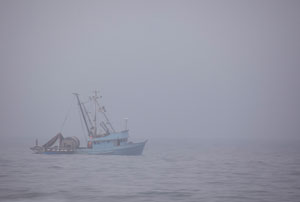
Add another mystery to the ghostly tales that haunt the windswept western coast. This one features a kayak, a dead man and the suspicion of hidden grave sites looted for souvenirs. But was it a crime? Whatever else, the discovery off the west coast of Vancouver Island in the early hours of July 24 this past summer was little short of spooky for the two weekend fishermen who made it.
What's that ahead?
Beyond Bamfield Harbour's tree-hung narrows, the pre-dawn sky brightened a little. Dan Ripley pushed the throttle of his fishing boat forward and turned the helm south. Wisps of fog wreathed the black water, limiting visibility through the semi-darkness to less than 100 feet. But the swell was light and past the surf line Ripley pushed the boat up to 17 knots. With him in the Law II this July morning was Dan Steele, like Ripley a contractor from the Lower Mainland. By 6 a.m. the pair were a mile off Cape Beale on course for a popular fishing bank 28 miles offshore.
Both men kept lookout for stray logs -- rare in the area at the height of summer, but always a threat. The modest swell spanked the hull as the big Yamaha outboard growled over the transom. Both men saw it at the same moment, in the periphery of their vision: a shape darker than the surrounding water, vaguely knife-like. It lifted above the surface for an instant, hung and slipped back beneath the waves. A log, hanging vertically in the water? Something about the profile seemed wrong. The dagger keel of a capsized sailboat? After a moment's discussion the two agreed they should go back and take a second look. Ripley slowed his boat and turned back. It took five more minutes drifting through the misty half-light, to find the mysterious object. When they did, the strangeness only intensified.
Bobbing vertically in the placid swells of the Strait of Juan de Fuca was the slender bow of a kayak. Reaching with a gaff, Dan Steele snagged the kayak's bow rope and pulled the swamped craft alongside the larger boat's aluminum hull. Hauling on the rope, the pair brought the kayak's bow up to their own boat's gunwhale and set about bringing it aboard. But even allowing for the water still trapped inside its hull, the small watercraft seemed unusually heavy. For half an hour they wrestled with its dead weight, the Law II tipping alarmingly close to the waves. At last Ripley called a halt and they settled on securing the kayak's bow rope to a cleat.
That was when the first inexplicable sight sent chills up the two fishermen's spines. Clearly visible in the gleaming dark wood of the custom hull were several round holes the size of a small finger, too perfectly rounded to be the result of an accidental collision. Four pierced the center of the hull near the single seat, "as if they'd held the drill between their legs and drilled down," Ripley recalls. Two more were drilled through the top of the kayak near the bow. (Later examination by the Coast Guard would find that in addition to being holed, the kayak had been weighted with at least two bags of sand.)
Creepiest catch
Unable to bring the kayak fully aboard, Ripley leaned out over the side to examine the cockpit. In the darkness behind the seat-back, he spotted a large backpack and wrestled it free. Like everything else inside the kayak it was soaked, but had not been in the water long enough to attract the marine growth that quickly colonizes most flotsam. Bringing the heavy pack to the center of the Law's deck, Ripley used a knife to cut open the laces. Upending it he partly emptied its contents onto the deck. Another chill washed over him.
"We cut it open and the first thing you see is hair, and my partner and I, we're like, 'holy shit!'" Ripley recounts. Spreading the small heap of sodden items out revealed that the hair was attached to several skulls, animal skulls true enough, but nonetheless a far creepier catch than any the two Dans had anticipated when they set out that morning. Examining the backpack more closely, Ripley extracted a brown manila envelope. Documents inside bore the same name set in a small brass plate inside the kayak cockpit: Richard Carl Mclean.
The bowl of the sky was still more dark than light when Ripley reached the Canadian Coast Guard on the radio. After some back and forth, the fishermen were instructed to stand by and await the James Mackay, en route from Bamfield to collect the troubling evidence.
While they waited for the Mackay to arrive, the crew of the Law poked through the strange assortment of items before them. The envelope held a birth certificate issued in California in 1954, and a Montana registration for a GMC pickup. Along with the skulls, Ripley says, the items included three grey stone arrowheads five to eight centimetres long, two knives in hand-sewn sheaths (the blades appearing to be hand-forged), and two or three entangled necklaces or bracelets made from bone and glass beads. Inside a small tin that might once have held chewing tobacco were more beads and a handful of individual stones that Ripley describes as like uncut purple gems wrapped in tissue.
Lying at idle, the fishing boat rocked heavily in the troughs between swells, the waves making wet slapping sounds against the thin aluminum hull. Waiting in the ghostly half-light, it was hard not to think of the kayak's missing owner. "It was one of the weirdest situations I've ever experienced, sitting there in the fog, kind of woozy in the morning, not saying anything," says Ripley, a former rancher, active hunter and experienced outdoorsman. "I've seen a lot. I've never seen anything like this."
Another grisly find
The whole scene "just didn't make any sense to me," says Dan Steele, who confirms Ripley's account of their strange find.
It was an hour before the Mackay arrived. Another 30 minutes before the kayak was secured aboard it. Steele and Ripley stuffed the strange assortment of artifacts back into the large green and black canvas pack, and passed it across to the Mackay's crew. The red rescue boat turned its bow north for Bamfield. Ripley brought his helm back to the south.
That was July 24 this year. And until recently neither Ripley nor Steele had any idea what else might lie behind their unsettling summer salvage. Ripley says Coast Guard authorities told him that among other items in the bottom of the canvas bag, they discovered a magazine for a small-calibre pistol -- but no gun. Both kayak and pack were turned over to the RCMP, but as of Oct. 26 neither man had heard from the police. The Port Alberni detachment of the RCMP at first deflected questions about the case, citing privacy laws, then referred them to the U.S. Coast Guard which, according to Staff Sergeant Lee Omilusik, had located the kayak's owner -- deceased.
Within 48 hours of Ripley and Steele's discovery off Cape Beale, a sailor catching the wind 10 miles off the tip of Washington State's Olympic peninsula had spotted a body in the water and radioed the U.S. Coast Guard. An investigation identified the corpse as the remains of Richard Mclean. Late in October, the U.S. Coast Guard closed its inquiry into Mclean's demise. "We're calling it an 'unattended death,'" said Coast Guard criminal investigator Juan Joi. "I haven't got any indication other than that a gentleman drowned out in the ocean." Mclean was "an avid boater and outdoorsman," the investigator said, who traveled often and had his truck set up for camping. The Montana resident had no criminal record, and investigation turned up no link to trafficking in archaeological artifacts.
Still, Mclean's profile fits the type that forensic anthropologist Grant Keddy, a frequent consultant on criminal cases involving ritual or native artifacts, says is most likely to trip, by accident or design, over archaeological remains in seldom-visited coves and islands along the remote west coast. Burial caves, where personal and cultural items were laid to rest alongside departed elders, are especially prized targets. "We know there are people snooping around our sites looking for stuff," Keddy says. The Museum has catalogued hundreds of burial caves along the coast, he says, and for obvious reasons does not advertise their locations. But not all remain secret. One inventoried cave held six skeletons in the 1970s, Keddy says: "Now there are none. Well, where did they go?"
Mists of doubt
B.C. law makes it illegal to remove artifacts even from the surface of an archaeological site. Nonetheless, such artifacts do come to light from time to time, Keddy says, often after a stint in someone's rec-room or den and later being put up for sale as a collection, with few questions asked about their origins. Individual items also turn up at online auction sites, but seldom command prices above a few hundred dollars (and much of what is advertised there is fake, the expert adds). "But mostly," Keddy says, "they're collecting it for themselves."
According to Staff Sergeant Lee Omilusik of the RCMP, the contents of Mclean's backpack were scrutinized at the Port Alberni detachment and determined to be of no significance. They and the kayak were turned over to Mclean's family.
That's par for the course when First Nations artifacts (real or suspected) turn up, Grant Keddy unhappily concedes. "These things generally don't get investigated. We have heard about an individual taking things from sites up-island, but how do you prove it?"
So how did Richard Mclean's kayak wind up nine-tenths submerged, barely piercing the swells off Cape Beale?
The U.S. Coast Guard's legal finding of 'unattended death' is about as void of content as any verdict imaginable. Did Mclean pack sandbags into his kayak, paddle out to sea, shoot holes in his expensive custom hull and toss his pistol overboard? A complicated way to commit suicide. And why pack along otter and coyote skulls (Ripley's guesses), trade knives and worked bone beads? Unless perhaps in a dark homage to the graves from which they may -- or may not -- have been looted.
Or did some other misadventure meet a man poking around the dark eaves of the rainforest for ancient graves? The case may be closed, the kayak returned to its rightful heirs, the ownership of the curious cargo Richard Mclean chose to pack on his last paddle of no further official interest. The mystery remains. ![]()
Read more: Travel















Tyee Commenting Guidelines
Comments that violate guidelines risk being deleted, and violations may result in a temporary or permanent user ban. Maintain the spirit of good conversation to stay in the discussion.
*Please note The Tyee is not a forum for spreading misinformation about COVID-19, denying its existence or minimizing its risk to public health.
Do:
Do not: